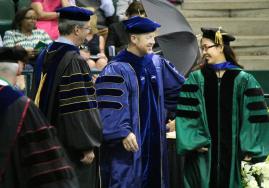A warning from the beginning: The following is a traditional view of the role of faculty members as they progress through their careers – not necessarily the roles of faculty members at all research universities today. However, reviewing these traditional roles will provide a different way of viewing a professor’s primary role.
These are the roles as they were described to me as a new Assistant Professor. As a Professor, with almost 20 years behind me, I look back at the advice with great pleasure since it has served me well during my career. Would I give the same advice now?…well, yes with a few modernizing modifications.

Associate Professors: The role of an Associate Professor is to serve. While gaining tenure, the future Associate Professor proved their value to the field, as a scholar, and began to lead their professional field. Service scholarship is distinguished in many ways to include chairing college and university committees and to serve in national leadership positions in professional associations. Associate Professors do not leave their research scholarship – but their primary emphasis is service scholarship leading to a national reputation. Service leadership expands the reputation of both their own scholarship and the reputation of their institution.
Full-Professor: The role of the Professor is to support. Grants and external funding provide an invaluable service to the institution and serve to support the scholarship of faculty within the institution. The reputation of a professor already established among their peers. They certainly continue to expand the reputation of their individual and institutional research, teaching and service scholarship, but their focus turn toward the support of the collegium. This support may be both in the form of monetary support, service leadership, and mentoring of colleagues.
Regents / Distinguished: Mentor. Build your space in scholarly community.
Teaching: The role of the faculty member as a teacher remains largely unchanged throughout the ranks. A professor is one who professes. At the heart of our profession is teaching. To move forward in the ranks of the professorate, teaching scholarship must be established and continuously improved during a career
The scholarship of teaching, research and service defines us as faculty at the university level.
The roles of each rank in the professorate blur as we continue. The roles of responsibility of each rank will further merge and become more complicated. Does is mean that we are wrong in today’s evaluation of the professorate? I remain skeptical, but hopeful.
Institution: University of North Texas, College of Information, Department of Learning Technologies
Position: Regents Professor and Director, Center for Knowledge Solutions
Note: I updated this from a previous writing in 2013.


Great reading your postt
LikeLike